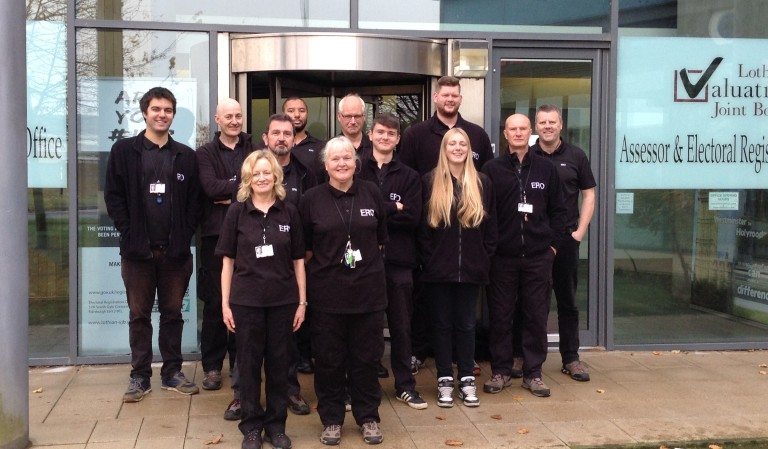Written by Steven Wicek, ICT Support Manager at Lothian Valuation Joint Board
Lothian Valuation Joint Board (LVJB) is responsible for the electoral register in the Edinburgh and Lothian regions in Scotland. As the leading board, we have the responsibility to value commercial and domestic properties within this region.
During Spring 2014, in preparation for the Scottish Independence Referendum, we wanted to check every household that did not have current information on who was eligible to register. Known as Void Canvass 2014, the Halarose Electoral Management System was queried using SQL to access all empty or ‘void’ properties. We then used ArcGIS to divide the data geographically so the Canvassers would receive forms on a daily basis with the Canvass manager allocating their daily workload.

At each property, new data was recorded using Data Collector. If the resident did not want to complete the digital form, Zebra printers were used to print off labels that included their property address. The label was then attached to a blank ‘Register to Vote’ application form and handed to the resident. If the form was completed and sent back it would be scanned into our system detecting the property details from the barcode. Members of the public were always actively encouraged to register electronically to make the process as efficient as possible.
Although the process worked well and was much more efficient than our previous way, there was still room for improvement. This resulted in our current project. The Household Enquiry Form (HEF) Canvass started in July 2015. The electoral register is constantly evolving so this canvass allowed us to locate and register new electors as well as confirm existing electors. The form was issued to about 400,000 properties in the Lothian area where one house equaled one form which could populate information for up to eight residents per household.
A few weeks after completing the HEF, we were able to identify non-returns as potential targets for door knocking. Over 120,000 records were returned. Using ArcGIS, these records were split into areas with a maximum of 7,000 records in each area. Mapping these areas gave us a much more efficient and automatic process than manually uploading CSV files. With the guidance of the iFormBuilder team, we used the API to send data to forms and send requests to delete records that were no longer required.
Fourteen canvassers were each assigned one of the 24 forms with pre-populated information. Each canvasser was tasked with completing their assigned form by either confirming details that the information was correct or making any changes to incorrect information which required using a subform to take the details of any new residents at the household or registering them to vote.
We wanted to give the canvassers the capability to request records as they needed them and that records would be automatically assigned to them based on their current GPS location on their iPad Mini. This would effectively allow the canvasser to always have records that are nearby to them geographically. It also allowed canvassers to manage their own workload and reduced the backend daily administration tasks such as assigning records to specific users.
The solution was to add another top level form assigned to every user. This was called the Household Request Form. The user would go to this form and request a certain amount of records, refresh their GPS location and send back the request. This would then download the requested number of records that were geographically closest to the point when they were requested them, to the individual form they had initially been assigned.
Once all household information is collected the record is emailed to a shared monitored mailbox with rules applied to the incoming mail. The rules consist of looking out for any changes to the form so that the admin staff can then process the changes on the live Electoral registration system.
We have a much more efficient, up to date, and true reflection of current electoral roll in our region. We now have a full-time canvass team of 12 that looks after over 400,000 properties in the region. The project has generated a great deal of interest from our colleagues countrywide.
This project took a team effort: David Lane mapping and manipulating data headers, Kier Murray building an automatic maintenance application to allow the API request to flow properly, and Bernie Callaghan and myself working with the Zerion team.
What has set iFormBuilder apart from other data collection platforms has been how user friendly it is. Our data collectors are wide-ranging, many had never picked up a tablet before but were able to use the product after one day. Since moving to this new workflow, we have seen a lot of interested in what we have done with our canvass and our operating process is smoother than it has ever been.
About the Author
Steven Wicek is Lothian Valuation Joint Board’s ICT Support Manager. In 2006, he went back to college and completed a Computer Technician course which led to working in Ireland’s largest NGO, Concern Worldwide. There, he gained extensive knowledge and hands-on experience on a number of IT platforms, including a rollout of virtual infrastructure to Concern’s remote offices. Steven joined the LVJB team in January 2014 where he led the shift towards using technology for data collection. He recently started an MSc in Advanced Security and Cybercrime at Napier University. Steven has completed the Edinburgh and Dublin marathons as well as his first mid-distance triathlon.



